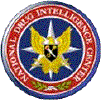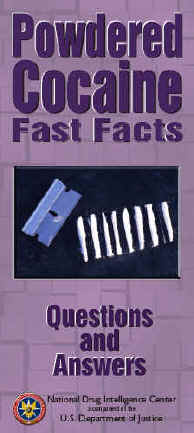What is powdered cocaine?
Powdered cocaine (cocaine hydrochloride) is a stimulant that is
extracted from the leaves of the coca plant, which is native to South
America. In the late 19th century cocaine was used as an anesthetic,
but the availability of safer drugs rendered many of its medical
applications obsolete. Today powdered cocaine is abused for the
intense euphoric effects it produces.

Cocaine typically is sold to users as a fine, white, crystalline
powder.
How is powdered cocaine abused?
Powdered cocaine typically is snorted (inhaled through the nose),
although it may be dissolved in water and injected. When snorted, the
drug is absorbed into the bloodstream through the nasal membranes. The
drug reaches the brain--and produces its euphoric effect--within 3 to
5 minutes. When injected, the drug is released directly into the
bloodstream and reaches the brain within 15 to 30 seconds.
To Top
Individuals of all ages use cocaine--data reported in
the National Household Survey on Drug Abuse indicate that an estimated
27,788,000 U.S. residents aged 12 and older used a form of cocaine at
least once in their lifetime. (Slightly more than 6 million of these
individuals used crack cocaine.)
Powdered cocaine use among high school students is a
particular concern. Seven percent of high school seniors in the United
States used the drug at least once in their lifetime, and 2 percent
used the drug in the past month, according to the University of
Michigan's Monitoring the Future Survey.
What are the risks?
Powdered cocaine is a powerful central nervous system
stimulant. Individuals who use the drug may become restless,
irritable, and anxious. Use of powdered cocaine also can result in
constricted blood vessels and increased temperature, heart rate, and
blood pressure. Heart attack, respiratory failure, stroke, and seizure
also may result from cocaine use. Using cocaine at the same time as
alcohol is consumed is particularly dangerous because it heightens the
cocaine's euphoric effect and potentially increases the risk of sudden
death.
Cocaine is a very addictive drug. Chronic users risk
developing tolerance to cocaine's effects. Many addicts report that as
tolerance develops they fail to achieve the positive effects they
experienced when they first began using the drug; thus, they begin to
use cocaine with greater frequency and in larger doses.
Cocaine users who inject the drug expose themselves to
additional risks, including contracting human immunodeficiency virus
(HIV), hepatitis B and C, and other blood-borne viruses.
To Top
What is it called?
The most common names for powdered cocaine are blow, nose candy,
nose powder, powder, and white powder. (Please see the Street Terms
text box below for additional names.)
Street Terms for Powdered Cocaine
Aspirin
Aunt
Birdie powder
Bolivian marching powder
Bouncing powder
Candy sugar
Devil's dandruff
Fast white lady
Flake |
Flave
Foolish powder
Friskie powder
Happy powder
Joy powder
Marching powder
Pariba
Powder diamonds
Shake |
Shrile
Soft
Star-spangled powder
Sugar boogers
Uptown
White boy
White dragon
Yao
|
|
Is powdered cocaine illegal?
Yes, powdered cocaine is illegal. Powdered cocaine is
a Schedule II substance under the Controlled Substances Act. Schedule
II drugs, which include PCP and methamphetamine, have a high potential
for abuse. Abuse of these drugs may lead to severe psychological or
physical dependence.
To Top
Other products of interest:
Check out Fast Facts on:
- Crack cocaine
- Crystal methamphetamine
- GHB
- Heroin
- Inhalants
- Jimsonweed
- Ketamine
|
- Khat
- LSD
- MDMA
- Methamphetamine
- PCP
- Powdered cocaine
- Prescription drugs
- Yaba
|
|
Also available from NDIC:
- Huffing--The Abuse of Inhalants
- Prescription Drug Abuse and Youth
- Drugs, Youth, and the Internet
For more information on illicit drugs check out our web site at:
www.usdoj.gov/ndic. Call 814-532-4541 to request NDIC products.
Our addresses:
National Drug Intelligence Center
319 Washington Street, 5th Floor
Johnstown , PA 15901-1622
Telephone: 814-532-4601
FAX: 814-532-4690
NDIC Washington Liaison Office
8201 Greensboro Drive, Suite 1001
McLean , VA 22102-3840
Telephone: 703-556-8970
FAX: 703-556-7807
NDIC publications are available on the following web sites:
ADNET http://ndicosa
LEO home.leo.gov/lesig/ndic
RISS ndic.riss.net
INTERNET www.usdoj.gov/ndic
To Top
|


